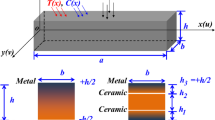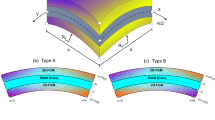Abstract
In this paper, in order to select a suitable method that is applicable to the large deflection with a small strain problem of pipe systems in the deep seabed mining system, the finite difference method with lumped mass from the field of cable dynamics and the substructure method from the field of flexible multibody dynamics were compared. Due to the difficulty of obtaining experimental results from an actual pipe system in the deep seabed mining system, a thin cantilever beam model with experimental results [7] was employed for the comparative study. Accuracy of the methods was investigated by comparing the experimental results and simulation results from the cantilever beam model with different numbers of elements. Efficiency of the methods was also examined by comparing the operational counts required for solving equations of motion. Finally, this cantilever beam model with comparative study results can be promoted to be a benchmark problem for the flexible multibody dynamics.
Similar content being viewed by others
References
T. N. Delmer, T. C. Stephens and J. A. Tremills, Numerical simulation of cable-towed acoustic arrays, Ocean engineering, 15 (6) (1988).
J. V. Sanders, A three-dimensional dynamic analysis of a towed system, Ocean Engineering, 9 (5) (1982).
S. Hong, Dreidimensionale nichtlineare statische und dynamische Analyse von flexiblen Rohrleitungen im Seegang, Doctoral Dissertation, Technical University of Aachen (1992).
S. Hong and S. W. Hong, A three-dimensional dynamic analysis of towed system, Part 1. A Mathematical Formulation, Journal of Ocean Engineering and Technology, 8 (1) (1994) 16–22.
S. C. Wu, A substructure method for dynamic simulation of flexible mechanical systems with geometric nonlinearities, Doctoral Dissertation, The University of Iowa (1987).
A. A. Shabana, Three dimensional absolute nodal coordinate formulation for beam elements: Theory, Journal of Mechanical Design, 123 (2001) 606–621.
W. S. Yoo, J. H. Lee, S. J. Park, J. H. Sohn, O. Dmitrochenko and D. Pogorelov, Large oscillations of a thin canti- lever beam: Physical experiments and simulation using the absolute nodal coordinate formulation, Nonlinear Dynamics, 34 (2003) 3–29.
R. Masoudi, T. Uchida, D. Vilela, A. Luaces, J. Cuadrado and J. McPhee, An update on the web-based library of computational benchmark problems for multibody dynamics, The 3rd Joint International Conference on Multibody System Dynamics and The 7th Asian Conference on Multibody Dynamics (2014).
G. Kirchhoff, Vorlesungen über mathematische Physik: Mechanik, Ch.29, Teubner, Leipzig (1876).
E. J. Haug, Computer aided kinematics and dynamics of mechanical systems, Allyn and Bacon (1989).
RecurDyn User’s Manual, Ver.8.3, Function Bay (2012).
J. T. Chung, Numerically dissipative time integration algorithms for structural dynamics, Doctoral Dissertation, The University of Michigan (1992).
N. M. Newmark, A method of computation for structural dynamics, Journal of Engineering Mechanics, ASCE, 85 (EM3) (1959) 67–94.
Author information
Authors and Affiliations
Corresponding author
Additional information
This paper was presented at the Joint Conference of the 3rd IMSD and the 7th ACMD, Busan, Korea, June, 2014. Recommended by Guest Editor Sung-Soo Kim and Jin Hwan Choi
Chang-Ho Lee received B.S. and M.S.. degrees in the department of Mechatronics Engineering of Chungnam National University in 2004 and 2006, respectively. He is working at KRISO in the research field on mining technology of deepseabed mineral resources. He is currently a Ph.D. candidate in intelligent robot system in Chungnam National University. His main research areas are numerical analysis using multi-body dynamics, development of simulation program and simulation based design.
Sung-Soo Kim received his Ph.D. degree in Mechanical Engineering from University of Iowa, U.S.A., in 1988. He is currently a professor of Mechatronics Engineering at Chungnam National University, Daejeon, Korea. His research interest is efficient analysis of rigid and flexible multibody dynamics.
Rights and permissions
About this article
Cite this article
Lee, CH., Hong, S., Kim, HW. et al. A comparative study on effective dynamic modeling methods for flexible pipe. J Mech Sci Technol 29, 2721–2727 (2015). https://doi.org/10.1007/s12206-015-0520-4
Received:
Revised:
Accepted:
Published:
Issue Date:
DOI: https://doi.org/10.1007/s12206-015-0520-4




